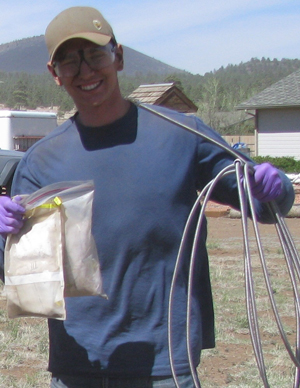Health officials in the Four Corners region continue to wrestle with a persistent plague pandemic that has the potential to infect humans.
Northern Arizona University undergraduate Bret Clawson is tracking the plague in prairie dog populations to better understand the bacterium’s persistence and prevent widespread outbreaks.
Clawson, a chemistry and biomedical science double major, collected two species of fleas that live on prairie dogs to learn more about the genetic structure of the plague. It is research that may provide insight into how fleas move in rodent populations.
“Any population of rodents can have a plague outbreak,” Clawson said. “This research helps county health departments determine if insecticidal dustings are necessary and when to treat to minimize the likelihood of an outbreak.”
Between 1,000 and 2,000 cases of human plague are reported worldwide each year, and plague is present in wild rodent populations throughout the United States. And there may be a connection between rodent outbreaks and human infection—14 percent of human plague occurrences in the United States coincide with plague outbreaks in prairie dogs.
“Previous studies have shown the greatest density of contemporary human cases of plague in the U.S. occurs in the Four Corners region,” Clawson said. “And prairie dog ranges overlap with the greatest concentration of plague cases.”
Clawson’s research builds on the work of Paul Keim, director of NAU’s Center for Microbial Genetics and Genomics, and Dave Wagner, NAU assistant professor of biological sciences, who published a study that traced the plague from China along its path around the world.
Keim and Wagner pinpointed the plague’s introduction to the western United States to the arrival of infected rats that scurried off ships in the ports of San Francisco more than a century ago. Clawson employed Keim and Wagner’s research methods of genome mapping to better understand how plague persists in the region.
This spring, Clawson was selected to present his findings at the National Conference on Undergraduate Research at Weber State University in Ogden, Utah. He also recently earned the award for best undergraduate poster at the American Society for Microbiology’s Arizona and Nevada chapter conference.
“I felt honored to be given the opportunity to present my work at both events,” Clawson said. “One thing I took from the experiences was a great sense of pride for belonging to the scientific community.”
Clawson has been involved in every step of his undergraduate research project—from collecting the fleas to completing the genetic mapping—an opportunity he said makes his undergraduate experience at Northern Arizona University enriching and meaningful.
“NAU has such a great environment for studying in the sciences,” Clawson said. “I’ve benefitted from the individual mentorship of faculty members and I’ve had exceptional opportunities. ”
Clawson said his research will lead to better understanding of vectors for plague in flea species, and that he plans to apply the skills he gains at NAU toward the medical field in virology or endocrinology. He will graduate in May of 2013.



